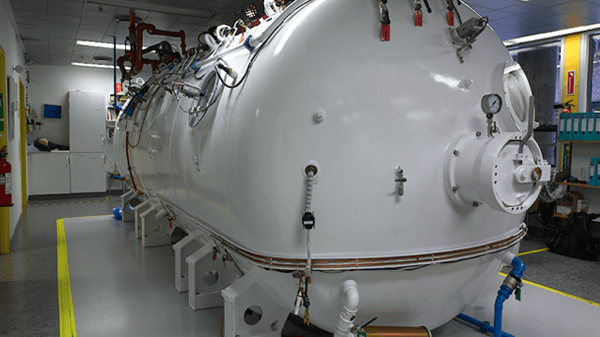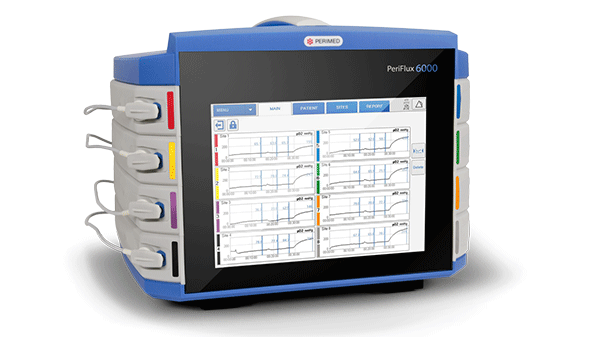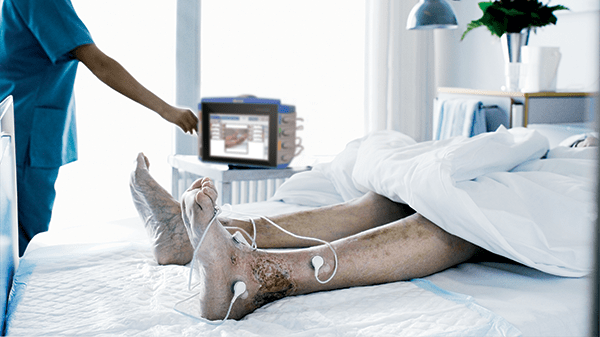
重症下肢虚血
一部の患者では、末梢動脈疾患が重症下肢虚血(CLI)に進行する場合があります。これはPADの最も重篤な段階です[6]。
CLIは、安静時の虚血性疼痛、潰瘍または壊疽を特徴とします。血液循環が非常に深刻な障害を受けるため、血行再建が不可能な場合、四肢切断のリスクがあります[6]。
PADの診断は、既往歴の聴取および脈拍の触診や足関節上腕血圧比(ABPI)を含む臨床検査が基本となります[6]。しかし、糖尿病患者集団では、足脈拍はPADの診断には十分でないことが示唆されています[15]。さらに、糖尿病患者ではABPI値2のうち1はかなり上昇します[16]。よって、PADの診断は、Global Vascular Guidelinesに従い、ABPI、足趾収縮期圧または経皮酸素分圧によって行われるべきです[12]。
TCOM(経皮酸素分圧測定)と高気圧酸素療法
経皮酸素分圧測定は、創傷の高気圧酸素療法(HBOT)で広く使用されています。HBOの候補者の可能性を予測するツールとして重要になっています[11]。
tcpO2の値を増加させる能力は、治癒の可能性を示します。酸素負荷試験は、吸気中の酸素分率が増加するとtcpO2値が上昇するかどうかを評価することを目的としています。上昇する場合、これらの患者にHBOは効果的であると考えられます[7]。
患者が呼吸を最大量で行っており、 tcpO2値が100 mmHgを超える場合は、大動脈疾患の可能性が低いことを示します[7]。
高気圧酸素療法では、30 mmHg未満の値は重度の動脈疾患を示唆します。tcpO2値が35 mmHgを超えている場合、HBO治療が効果的である可能性を示します[7]。
HBO治療の開始は、糖尿病性足病変に有益であるかを評価する最良の方法です。200 mmHgを超える値は、治癒が成功したことを示す指標です。ただし、100 mmHg未満の値はHBO治療の失敗と密接に関連しています[7]。




PeriFlux 6000 経皮酸素分圧測定装置
PeriFlux 6000は下肢創傷患者の評価をサポートします。組織内の経皮酸素分圧を測定することにより、患者の四肢の微小血液循環を測定できます。
患者の四肢の酸素化レベルに関する情報を入手し、創傷の明確な全体像を把握します。
参考文献
- Barnikol W et al. A novel, non-invasive diagnostic clinical procedure for the determination of an oxygenation status of chronic lower leg ulcers using peri-ulceral transcutaneous oxygen partial pressure measurements: results of its application in chronic venous insufficiency. German Medical Science 2012; 10: 1-22.
- Padberg F et al. Transcutaneous oxygen (tcpO2) estimates probability of healing in the ischemic extremity. Journal of Surgical Research 1996; 60, 59: 365-369.
- Fowkes F et al. Comparison of global estimates of prevalence and risk factors for peripheral artery disease in 2000 and 2010: a systematic review and analysis. The Lancet 2013; 382: 1329-40.
- Muntner P et al. Relationship between HbA1C level and Peripheral Artery Disease. Diabetes Care 2005; 28,8: 1981-87.
- Lo T et al. Prediction of Wound Healing Outcome Using Skin Perfusion Pressure and Transcutaneous Oximetry: a single-center experience in 100 patients. The Wound Treatment Center and Hyperbaric Medicine Service 2009; 21,11: 310-316.
- National Clinical Guideline Centre. Lower limb peripheral arterial disease, diagnosis and management, NICE Clinical Guideline 147. The National Clinical Guideline Centre, 11 St. Andrews Place, Regents Park, London NW1 4BT – United Kingdom, 2012.
- Fife CE et al. Transcutaneous oximetry in clinical practice: consensus statements from an expert panel based on evidence. University of Texas Health Science Center 2007; 36,1: 43-53.
- Norgren L et al. Inter-Society Consensus for the Management of Peripheral Arterial Disease (TASC II). Eur J Vasc Endovasc Surg 2007; 33: 1-75.
- Bunt TJ et al. tcpO2 as an accurate predictor of therapy in limb salvage. Maricopa Medical Center 1996; 10, 3: 224-27.
- Kaur S et al. Evaluation of the efficacy of hyperbaric oxygen therapy in the management of chronic nonhealing ulcer and role of periwound transcutaneous oximetry as a predictor of wound healing response: a randomized prospective controlled trial 2012; 28,1: 70-75.
- Sheffield PJ. Measuring tissue oxygen tension: a review. Undersea Hyperbaric Medical Society 1998; 25,3: 179-188.
- Conte MS, Bradbury AW, Kolh P et al. Global vascular guidelines on the management of chronic limbthreatening ischemia. J Vasc Surg. 2019 Jun;69(6S):3S-125S.e40
- Hinchliffe RJ, Brownrigg JR, Apelqvist J et al. International Working Group on the Diabetic Foot. IWGDF guidance on the diagnosis, prognosis and management of peripheral artery disease in patients with foot ulcers in diabetes. Diabetes Metab Res Rev. 2016 Jan;32 Suppl 1:37-44.
- Hingorani A, LaMuraglia GM, Henke P et al. The management of diabetic foot: A clinical practice guideline by the Society for Vascular Surgery in collaboration with the American Podiatric Medical Association and the Society for Vascular Medicine. J Vasc Surg. 2016 Feb;63(2 Suppl):3S-21S.
- BBarshes NR et al. The system of care for the idabetic foot: objectives, outcomes and opportunities. Diabetic Foot & abjkem 2013.
- Portier et al. Use and Utility of Ankle Brachial Index in Patients with Diabetes. European Society for Vascular Surgery. 2010; 41:110-116
このウェブサイトではクッキーを使用しています
クッキーの使用について有効な電子メールアドレスを入力してください
Microsoft Azure ADを使用してサインインするための招待の電子メールがすぐに送信されます。
お客様の電子メールが登録されていないようです
メールの「スタート」をクリックして登録プロセスを終了させてください。
ラジオメーターでは、文書、リソース、お客様およびパートナー向けの当社カスタマー・ポータルのその他サービスへの安全なアクセスを提供するため、Microsoft Azure ADを使用しています。
お客様の所属機関がすでにAZURE ADを使用していれば、ラジオメーターのカスタマー・ポータルへのアクセスに同じ認証を使用することができます。
重要な利点
- 既存のActive Directory認証を使用できる
- 1回のサインオン
- 今後のサービスへのアクセスに同じ認証を使用
アクセス要求
お客様の要求が承認されると、当社のサービスへのアクセスに招待する電子メールが送信されます。
この招待に応じ、かつ、お客様の所属機関がAZURE ADをすでに使用していれば、ラジオメーターのカスタマー・ポータルへのアクセスに同じ認証を使用することができます。または、サインイン用のワンタイムパスワードがメールで送信されます。


